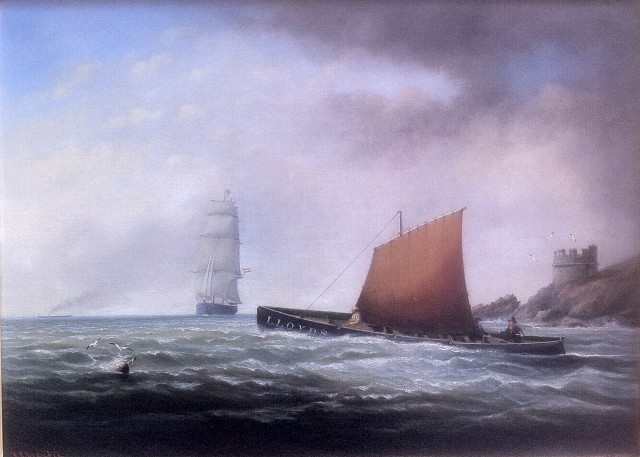ALEXANDER KAY BRANDEN (1817 – c1905)
A LLOYDS PILOT GIG
A GIG UNDER SAIL, TAKING A PILOT OUT TO A VESSEL. LITTLE DENNIS BLOCKHOUSE, FALMOUTH TO THE RIGHT.
Oil on canvas
43cm x 60xm
A rare painting offering valuable evidence about the gigs of the time.
THE ARTIST: ALEXANDER KAY BRANDEN
Branden was a maritime artist who painted ships with some accuracy of detail. He would have been commissioned to paint vessels as they arrived into port.
His understanding of boats would have developed over a life spent close to shipping. His father was a Warrant Officer in the navy and the family lived in Wilcove, south- east Cornwall, a waterside village directly across the River Tamar from the great dockyards of Plymouth Devonport .
By 1891, after a career at sea, Branden was living as a Naval Pensioner in Middle Terrace, Falmouth. He appears in the 1891 census but not the 1881, so he must have moved there after 1881. His pictures frequently depict the subject boat on the water with a recognisable landmark to the left or right – with the little castellated building on the headland below Pendennis Castle seen here.
THE GIG
There is much of interest here. Sailing ships arriving in port would signal for a pilot to take them in past the hazards to safe harbour. There was fierce competition among the pilots to be the first out to the ship and thus get the payment . The gigs that carried the pilots were sleek and necessarily fast; the race to the ship lies behind the modern sport of gig racing (which still uses some of the old gigs).
Gigs were usually powered by oarsmen but sails were used also. This painting offers rare and important evidence about how sail was operated. You would expect the oars to have metal rowlocks but close inspection shows that the oars are operated though spaces in the body of the gig.
The top panel of the side of the gig does not extend quite to the end of the bow and only runs about halfway back. It appears that this top board was a separate removable item. It was not only inserted when the sail went up- and then because the gig would lean over more because of the sail. This painting is perhaps the only known evidence of this practice.
THE PEOPLE IN THE GIG
Sitting quietly before the sail is the pilot in his yellow waterproofs, ready to go aboard the big sailing ship that is on its way in. Behind the sail are two gig men who wear distinctive uniforms. It is believed that their uniforms can be identified as being from one of the companies operating from Falmouth.
LLOYDS
Lloyds of London remain immensely important in the maritime world today. Here they have probably chartered the gig from the local firm. With the Lloyds name written large on the side of the gig, there is no doubting the message here: Lloyds is the company out in the lead! This is effective advertising.
PROVENANCE
The painting belonged to a family involved with shipping in Falmouth.
ACKNOWLEDGEMENT
I am grateful to the National Maritime Museum for their assistance with this research.
